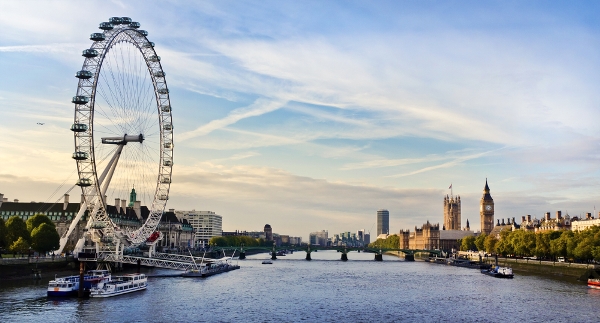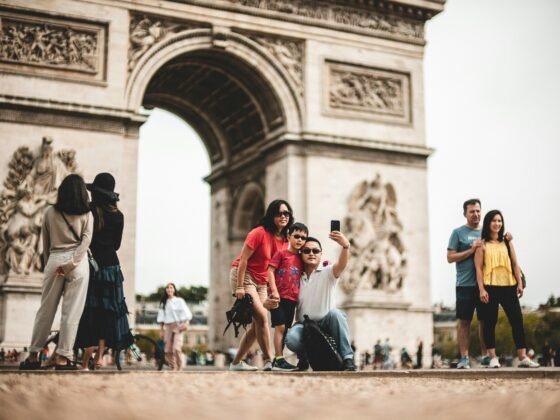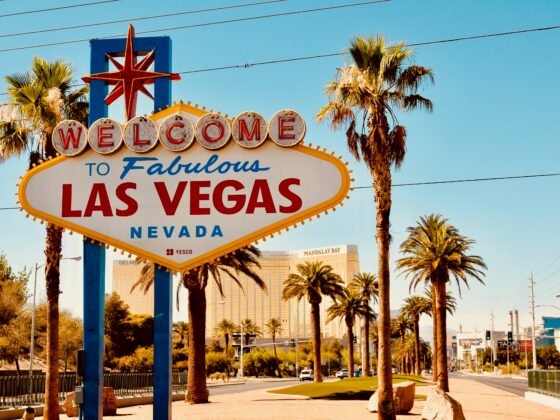One of the most popular city break destinations in the world, London never fails to wow with its fascinating heritage, diverse culture and traditional history. With opulent palaces, world-famous museums, iconic monuments, sprawling city parks, pulsating arts, world-class shopping and of course that Olympic legacy, you’ll never be bored in London!
Ride the London Eye – Start your visit to London by getting to grips with the lay of the land! The modern landmark that is the London Eye is a massive Ferris wheel situated on the South Bank of the River Thames and is in fact the third biggest observation wheel on earth. A ride to the top (at 135 meters tall) provides you with a breathtaking panoramic view of all of central London (weather permitting of course!) On a clear day travellers can see up to 40 km (25 miles) away – so check the forecast before booking your pod! The London Eye has 32 enclosed capsules to ride in, each of which holds up to 25 people. Opened in March 2000, riders can walk about the capsules freely to enjoy the view from all angles and the ride lasts about 30 minutes.
Admire the House of Commons, aka The Palace of Westminster – The site of the Palace of Westminster is also more commonly known as the House of Commons and the House of Lords. Located in London’s Westminster, together these buildings host the British Parliament and have been the centre of British government for almost a thousand years. The original palace was destroyed by fire in 1834; the present palace has stood on the same site since 1840, surviving multiple bombings during World War II. All visitors can attend debates, watch committee hearings or take a tour of Parliament, but only permanent UK residents can go inside the Elizabeth Tower and Big Ben. Tours are available most Saturdays throughout the year.
Gawp at Westminster Abbey’s architecture – Located next to the Palace of Westminster, Westminster Abbey is a large church with some of the most impressive Gothic architecture in the world. It has traditionally been the site of royal weddings, coronations, funerals and memorials. The most famous recent wedding here of course that of Catherine Middleton and Prince William on 29 April 2011. The Abbey contains a museum featuring a collection of royal historical pieces. The ringing of the Abbey bells is an event that occurs several times per month, usually on holidays. The Abbey is open Monday through Saturdays to visitors; Sundays are set aside for worship services, at which all are welcome. Don’t miss the exquisite Henry VII’s Lady’s Chapel at the eastern end of the Abbey.
Experience the Tate Britain and Tate Modern – The Tate Britain is part of the Tate network of art galleries which house Britain’s national collection of British Art and International Modern and Contemporary Art from the year 1500 to the present day. The Tate Modern, also in central London, houses the collection of international modern art. Admission to both the Tate Britain and Tate Modern is free with the exception of a handful of special exhibitions. The Tate Britain holds an event called “Late at Tate Britain” on select Friday nights which includes free film screenings, events and talks.
Discover the pomp and ceremony of Buckingham Palace – Buckingham Palace is the home of the British royal family and is the number one cultural must-see sight in London. Like Westminster Palace, the site has been a centre of British power for the better part of a thousand years, but the buildings that currently occupy it were mostly constructed in the 1700s and 1800s. The Palace is used today for state functions and visits from overseas dignitaries. Buckingham Palace’s State Rooms and Garden are open daily to visitors year round, except when state ceremonies and special events are taking place.
Wander Trafalgar Square – Often considered to be the core of central London, Trafalgar Square is a public area rich in national history. Originally the site of the King’s Mews (a stable and carriage house), the square was commissioned in the early 1800s as a public space and a memorial to the British Navy’s victory at the Battle of Trafalgar. The square features statues and fountains that are lit up with brightly coloured LEDs at night. It is open to the public daily, and is regularly the site of major holiday events, sports celebrations and political rallies.
Take in the exquisite Shakespeare’s Globe Theatre – The original Globe Theatre dates back to 1599, when it was built by Shakespeare’s playing company. It didn’t last long, being burned down in an accidental fire in 1613, but it took almost 400 years for this recreation to be built. Shakespeare’s Globe opened in 1997 and stages performances in the summer to capacity crowds of 3,000 people. Located on London’s bankside, exhibitions and tours are conducted daily with the exception of Christmas Eve and Christmas Day.
Discover Sir John Soane’s Museum – John Soane (1753–1837) was a Neo-Classical architect best known for designing the Bank of England and the Dulwich Picture Gallery. The museum is on the site of his personal home and office within the city of Westminster and features the items he collected over the course of his life. Soane’s collection includes a library of rare manuscripts, paintings, sculpture, antiquities and architectural models. The museum is open Tuesdays through Saturdays and admission is free.
Explore the fascinating British Museum – Founded in 1753, the British Museum is one of the largest in the world with an estimated 8 million works on exhibit. The massive museum has departments covering nearly every geographic region of the world past and present as well as departments devoted to prehistory, prints and drawings, and coins and medals. Visitors are advised to focus on a particular section they are most interested in as the museum is far too large to take in on only one visit. British treasures include the ‘Snettisham Hoard’ which includes hundreds of gold torc (neck ring) fragments, which were uncovered in Snettisham in Norfolk. Don’t miss the ‘Mildenhall treasure’ which consists of Roman Empire period silver tableware which were uncovered in the Suffolk town in 1946. Admission to the museum is free, and it is open every day. Various free tours and talks are also offered at this amazing museum.
Visit the Royal Academy of Arts @ Burlington House – In spite of the name, the Royal Academy of Arts is a privately owned and funded institution. Aside from offering academic courses, the Royal Academy also has galleries available for visitors to view. The collection primarily focuses on British artists from the 18th century to the present day. Opening times are daily with the exception of Sundays and December 24-26.
Browse The National Gallery – Adjacent to Trafalgar Square, the National Gallery is a collection of over 2,000 paintings ranging from the 1400s to 1900. Founded originally in the late 1700s as a collection of royal art, the Gallery has a particularly impressive collection of portraits. Top three must-see paintings include Rembrandt’s Self Portrait at the Age of 34, Canaletto’s The Stonemason’s Yard and Venus and Mars from Sandro Botticelli. The National Gallery is open daily with the exceptions of Christmas Eve, Christmas Day and New Year’s Day. Admission is free.
Soak up the entertainment at the Barbican Centre – The Barbican Centre is an entertainment venue on London’s Silk Street that regularly hosts musical performances, film screenings, art exhibitions and theatre performances. It was built in the 1960s as part of a project to renovate an area of London ruined by the bombs of World War II and is now the largest performing arts centre in Europe. The BBC Symphony Orchestra and the London Symphony Orchestra both regularly perform here. The Barbican is open daily (with the exception of December 24-26) and regular tours are offered for a fee. Many of the regular events are free and open to the public to drop in on, such as the Big Barbican Adventure (a walking tour for families) and exhibitions by artists from around the world.
Check out the superb Museum of London – Part of the Barbican Center, the Museum of London represents the entire history of the city of London. Galleries are arranged chronologically, so that visitors can see the development of the city over time. The Museum of London Docklands, a separate venue, chronicles London’s trade history as one of the world’s major port cities. Don’t miss the Cheapside Hoard: London’s Lost Jewels exhibition, the Suffragettes collection and the Personal adornment in Jacobean London event. Like many museums and galleries in London, admission is free and the museum is open daily, with the exception of December 24-26.
Admire the exquisite St. Paul’s Cathedral – St. Paul’s Cathedral is one of London’s most famous and instantly recognisable landmarks. It is not simply a historical relic, however, but is a fully functioning church that still holds daily services. The original St. Paul’s was destroyed in London’s Great Fire of 1666, but this replacement has stood since 1711, surviving direct bombing attacks during World War II. One of London’s unmissable sights, services occur daily and visitors can also ascend to the dome and explore the underground crypt.
Sup a pint at the Old Bank of England – For the quintessential pub experience with a twist, try the Old Bank of England on Fleet Street. The name is no misnomer as the pub is actually built on the site of the former Bank of England, with a beautifully renovated interior. The site started out as tavern in the 16th century but was demolished in 1888 to allow construction of the Bank of England. However in 1975 it was turned into a building society before becoming a tavern once more in 1994. The interior has been lovingly restored and features an opulent bar area. And did you know that the tunnels beneath the pub are purportedly where the infamous barber Sweeney Todd butchered his victims. Enjoy that meat pie!
Browse your heart out at Old Spitalfields Market – Old Spitalfields Market is on the location of one of London’s historical food markets dating back to the early 1600s. Food is still sold here, but the focus is now on various other wares such as clothing and even electronics. Old Spitalfields Market is open daily, but sees the most traffic on Sundays. New Spitalfields Market is more of a focused farmer’s market specialising in fruit, vegetables and flowers. It is also open daily and most heavily visited on weekends.
Hang out at Piccadilly Circus – Piccadilly Circus is an open public area anchored by a famous Statue of Eros. Built in 1819, it connects the major shopping streets Regent and Piccadilly and is full of people at nearly all hours of the day. It is the home of the Criterion Theatre and London Pavilion as well as a number of popular clothing, sporting goods and food shops to suit all tastes and budgets. Piccadilly Circus also has its own tube station, offering convenient access.
Eat until you burst at London’s Upper Street Restaurants – London is a world-class city and features too many good restaurants to list independently, but one good central source to sample the variety of cuisines available is Upper Street. Upper Street has a little bit of everything available – Thai, Italian, Japanese: everything from upmarket dining to fish and chips. If you’re not quite sure what you want to eat, it’s a great location to browse as the restaurants are all in close proximity to each other along the street. Upper Street offers the widest range of available dining at night.
Enjoy authentic Chinatown – London’s Chinatown has moved several times throughout history, but the present iteration is located just off Shaftsbury Avenue and remains one of the most awesome things to do in central London. It has 80 restaurants and is the prime location for Asian dining in London. Worth seeing are also the intricate pagodas and statues, as well as shopping and bakeries. If travelling by tube, Chinatown can be easily accessed from the Piccadilly Circus station.
Don’t miss riding on London’s iconic buses – London’s double-decker buses are an iconic symbol of the city and also provide a convenient opportunity for sightseeing. Many lines run through central London area on a regular basis. Invest in an Oyster card, which is the most convenient means of getting about, allowing users to simply touch in and out when riding London’s public transit. They can also be topped up online.












